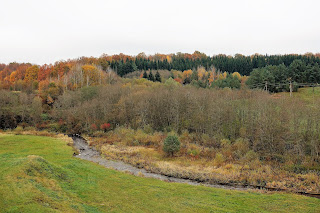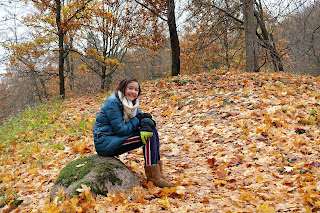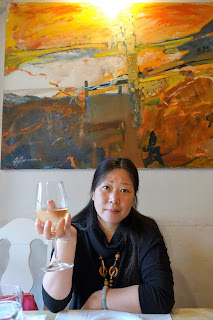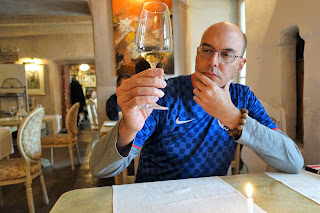Apparently gentlemen need to be on their guard while in Klaipeda
Klaipėda (population 161,000) is the third-largest city in Lithuania, after Vilnius and Kaunas. Known as Memel until 1925, the city was founded in 1252 by the Teutonic Order; it became part of Prussia following the Napoleonic Wars of the early 19th century, and remained so until 1923. An "international territory" under the Treaty of Versailles,
Lithuanian troops marched in, annexed it and changed the name to Klaipėda (probably to compensate for having lost Vilnius to the Poles after the First World War). It's now Lithuania's only sea port, but the cobblestoned Old Town still retains hints of its German past despite widescale destruction during World War II. It was across the Danė River in New Town, however, that we rolled into the city on a rainy Friday evening and quickly settled into our room at the
Litinterp Guesthouse.
The weather proved to be more cooperative on Saturday morning as we set out for Klaipėda Castle. The original fortress dates from the 13th century before being completely razed in the late 19th century. Once surrounded by a moat, the earth ramparts are undergoing a large EU-funded reconstruction project, presumably with the aim of returning the castle to a semblance of its former glory. In the meantime, visitors can check out the two-part exposition. The first section details the history of the castle itself:
Back outside, between expositions:
The other section covers the story of Memel/Klaipėda:
Note the Lenin impersonator above in this 1967 photo of a parade celebrating fifty years since the October Revolution
One of the many sculptures studded around central Klaipėda:
In Old Town the girls pose for a photo in Teatro aikštė (Theater Square). Behind them is a fountain dedicated to
Simon Dach, a German poet born in Klaipėda in 1605. The girl on the pedestal is
Ānnchen von Tharau, the subject of a poem by Dach (the original statue was erected in 1912 by Berlin artist Alfred Kune, but was destroyed in the Second World War). The building in the background is the Klaipėda Drama Theater, built in 1857. None other than Adolf Hitler stood on the balcony to proclaim Memel's incorporation into Germany during World War II:
Following lunch at a Chinese restaurant called Jing Bin Lou, Amber and I tagged along while Shu-E did some shopping at the aptly-named
Amber Queen. After much browsing she eventually settled on a reasonably-priced ring, deciding not to sacrifice our daughter's college fund on some of the more elaborate objects:
Old Town street scene:
One of the most attractive buildings in Old Town houses the
History Museum of Lithuania Minor (
Mažosios Lietuvos Istorijos Muziejus):
My wife decided to relax in the sculpture garden down the street while my daughter and I went inside. A quick look up at the sky noted some ominous signs:
The museum covers the history of the region once known as East Prussia, going back to Neolithic times. The story is told through the collections of clothes, coins, maps, models, photographs and postcards. Or, in this case, an old wooden well that was used for washing clothes:
The Teutonic Knights introducing Christianity to the pagans of the Baltic region in the way they knew best:
The first individual map of Lithuania, dating from 1595:
Amber and I emerged from the museum to find the street soaked with water, the result of a brief but heavy downpour while we were inside. Shu-E was prepared, however, and "weathered" the rainfall rather well:
Lonely Planet describes this red dragon as "disturbing":
Taking a break at
Max Coffee:
Lithuania's largest granite sculpture, entitled
Arka (Arch), celebrating Klaipėda joining Lithuania in 1923. The engraved quote by local poet Ieva Simonaitytė translates as "We are one nation, one land, one Lithuania":
A floating restaurant on the Danė called Meridianas:
Yet another sculpture:
Back in our room to drop off some of our things before going back out to have dinner:
A memorial to local sons killed during the
Soviet-Afghan War:
Our first choice for dinner, the
Momo Grill steakhouse, proved to be too busy, so instead we went Lithuanian by eating at
Senoji Hansa, where I had the "Hansa Fish" (rainbow trout):
On Sunday we checked out of the Litinterp Guesthouse and took the car ferry for the short ride across the Curonian Lagoon to the Smiltynė district, home to the
Lithuanian Sea Museum (
Lietuvos Jūrų Muziejus):
Damn, just can't seem to get away from work:
The highlight for Amber was the dolphin and sea lion show. Having seen
The Cove, I have my issues with such performances, but my daughter was happy, so I spared her the lecture:
While the girls relaxed indoors after the show, I went outside to check out the Ethnographic Sea Fishermen's Farmstead, highlighted by three Baltic Sea fishing trawlers built between 1949 and 1961:
The traditional 19th-century buildings were shut at the end of the tourist season, but visitors can still get a glimpse of traditional Curonian fishing life:
Cellar
Cattle shed, with a live German shepherd to keep the tourists out (note the white sign on the gate)
Granary
Looking across the lagoon at Klaipėda's port:
The Baltic Sea on the opposite side of the Curonian Spit:
Back on the car ferry for the long drive back to Vilnius:
A car ferry heading in the opposite direction. A few seconds later it had to veer sharply starboard and come to a halt in order to let a large container ship pass in front of its bow:






















































































